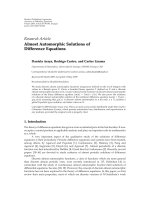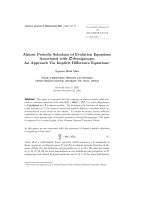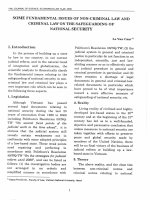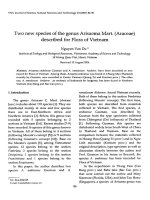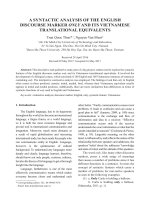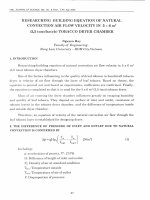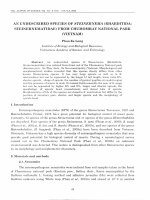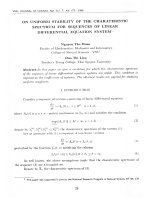DSpace at VNU: Almost automorphic solutions of evolution equations
Bạn đang xem bản rút gọn của tài liệu. Xem và tải ngay bản đầy đủ của tài liệu tại đây (199.72 KB, 10 trang )
PROCEEDINGS OF THE
AMERICAN MATHEMATICAL SOCIETY
Volume 132, Number 11, Pages 3289–3298
S 0002-9939(04)07571-9
Article electronically published on June 18, 2004
ALMOST AUTOMORPHIC SOLUTIONS
OF EVOLUTION EQUATIONS
TOKA DIAGANA, GASTON NGUEREKATA, AND NGUYEN VAN MINH
(Communicated by Carmen C. Chicone)
Abstract. This paper is concerned with the existence of almost automorphic
mild solutions to equations of the form
(∗)
u(t)
˙
= Au(t) + f (t),
where A generates a holomorphic semigroup and f is an almost automorphic
function. Since almost automorphic functions may not be uniformly continuous, we introduce the notion of the uniform spectrum of a function. By
modifying the method of sums of commuting operators used in previous works
for the case of bounded uniformly continuous solutions, we obtain sufficient
conditions for the existence of almost automorphic mild solutions to (∗) in
terms of the imaginary spectrum of A and the uniform spectrum of f .
1. Introduction and notation
In this paper we deal with the existence of almost automorphic mild solutions
to evolution equations of the form
du
= Au + f (t),
(1)
dt
where A is a (unbounded) linear operator that generates a holomorphic semigroup
of linear operators on a Banach space X and f is an almost automorphic function
taking values in X.
This problem has been of great interest to many mathematicians for decades.
Actually, it goes back to the characterization of exponential dichotomy of linear
ordinary differential equations by O. Perron. The reader can find many extensions
of the classical result of Perron to the infinite-dimensional case in [4, 11, 15, 17, 27]
and the references therein with results concerned with almost periodic solutions and
bounded solutions. Recently, the interest in finding conditions for the existence of
automorphic solutions has been regained (see, e.g., [21, 26]). Some extensions of
results on almost periodic solutions have been made in [10]. In this direction, we
study conditions for the existence and uniqueness of almost automorphic solutions
to Eq. (1). The idea of using the method of sums of commuting operators to
study the existence of almost periodic solutions is due to Murakami, Naito and
Minh [15]. This method works smoothly in the framework of evolution semigroups
Received by the editors July 16, 2003.
2000 Mathematics Subject Classification. Primary 34G10; Secondary 43A60.
Key words and phrases. Analytic semigroup, almost automorphic solution, uniform spectrum,
sums of commuting operators.
c 2004 American Mathematical Society
3289
License or copyright restrictions may apply to redistribution; see />
3290
TOKA DIAGANA, GASTON NGUEREKATA, AND NGUYEN VAN MINH
associated with evolution equations. However, in our problem setting, in general,
the associated evolution semigroups are not strongly continuous since almost automorphic functions are not necessarily uniformly continuous. Other methods of
proving the existence of bounded and uniformly continuous solutions in [23, 27] are
inapplicable due to the explicit use of uniform continuity. The main task in this
paper is to overcome this difficulty to prove a necessary and sufficient condition
for the existence and uniqueness of almost automorphic mild solutions of the form
σ(A) ∩ i sp(f ) = . To this end, we introduce the notion of uniform spectrum of
a function, which turns out to be appropriate for extending the method of sums
of commuting operators to the case of non-uniform continuity. Our main results
obtained in this paper are Theorem 4.5 and Corollary 4.6.
Notation. Throughout the paper, R, C, X stand for the sets of real, complex
numbers and a complex Banach space, respectively; L(X), BC(R, X), BU C(R, X),
AP (X) denote the spaces of linear bounded operators on X, all X-valued bounded
continuous functions, all X-valued bounded uniformly continuous functions and almost periodic functions in Bohr’s sense (see [14, p. 4]) with sup-norm, respectively.
The translation group in BC(R, X) is denoted by (S(t))t∈R , which is strongly continuous in BU C(R, X) and whose infinitesimal generator is the differential operator
d/dt. For a linear operator A, we denote by D(A), σ(A) and ρ(A) the domain,
spectrum and resolvent set of A, respectively. If Y is a metric space and B is a
¯ denotes its closure in Y . In this paper by the notion of sectorial
subset of Y , then B
operators is meant the one defined in [22]. The notion of closure of an operator is
referred to the one defined in [6].
2. Spectral theory of functions
2.1. Spectrum of a function in BC(R, X). In the present paper, for u ∈
BC(R, X), sp(u) stands for the Carleman spectrum, which consists of all ξ ∈ R
such that the Carleman-Fourier transform of u, defined by
∞
−λt
(Reλ > 0),
0 e u(t)dt
u
ˆ(λ) :=
∞
− 0 eλt u(−t)dt (Reλ < 0),
has no holomorphic extension to any neighborhoods of iξ (see [23, Prop. 0.5, p.
22]). For each u ∈ BC(R, X) we denote Mu := span{S(τ )u, τ ∈ R}, which is a
closed subspace of BC(R, X). If u ∈ BU C(R, X), the Carleman spectrum of u
coincides with its Arveson spectrum, defined by (see [2, Lemma 4.6.8])
isp(u) = σ(Du ),
where Du is the infinitesimal generator of the restriction of the group of translations
(S(t)|Mu )t∈R to the closed subspace Mu .
Below we list some properties of the spectra of functions which we will need in
the sequel.
Proposition 2.1. Let u, un , v ∈ BC(R, X) be such that limn→∞ un − u = 0, and
ψ ∈ S. Then
(i) sp(u) is closed,
(ii) sp(u + v) ⊂ sp(u) ∪ sp(v),
˜
(iii) sp(ψ ∗ u) ⊂ sp(u) ∩ suppψ,
License or copyright restrictions may apply to redistribution; see />
ALMOST AUTOMORPHIC SOLUTIONS
(iv)
(v)
(vi)
(vii)
3291
˜
sp(u − ψ ∗ u) ⊂ sp(u) ∩ supp(1 − ψ),
if ψ˜ ≡ 1 on a neighborhood of sp(u), then ψ ∗ u = u,
if sp(u) ∩ suppψ˜ = ∅, then ψ ∗ u = 0,
if sp(un ) ⊂ Λ, ∀n, then sp(u) ⊂ Λ.
Proof. We refer the reader to [23, Prop. 0.4, Prop. 0.6, Theorem 0.8, pp. 2025].
2.2. Uniform spectrum of a function in BC(R, X). Notice that for every λ ∈ C
with λ = 0 and f ∈ BC(R, X) the function ϕf (λ) : R t → S(t)f (λ) ∈ X belongs
to Mf ⊂ BC(R, X). Moreover, ϕf (λ) is analytic on C\iR.
Definition 2.2. Let f be in BC(R, X). Then,
(i) α ∈ R is said to be uniformly regular with respect to f if there exists a
neighborhood U of iα in C such that the function ϕf (λ), as a complex
function of λ with λ = 0, has an analytic continuation into U.
(ii) The set of ξ ∈ R such that ξ is not uniform regular with respect to f ∈
BC(R, X) is called the uniform spectrum of f and is denoted by spu (f ).
If f ∈ BU C(R, X), then α ∈ R is uniformly regular if and only if it is regular
with respect to f . In fact, this follows from the fact that for bounded uniformly
continuous functions u we have
isp(u) = σ(Du ).
(2)
Next, using the identity
∞
R(λ, Du )u =
e−(λ)ξ S(ξ)udξ,
λ=0
0
we get the claim. For f ∈ BC(R, X), in general, the above (2) may not hold. We
now study properties of uniform spectra of functions in BC(R, X).
Proposition 2.3. Let g, f, fn ∈ BC(R, X) be such that fn → f as n → ∞, and let
Λ ⊂ R be a closed subset. Then the following assertions hold:
(i) spu (f ) = spu (f (h + ·));
(ii) spu (αf (·)) ⊂ spu (f ), α ∈ C;
(iii) sp(f ) ⊂ spu (f );
(iv) spu (Bf (·)) ⊂ spu (f ), B ∈ L(X);
(v) spu (f + g) ⊂ spu (f ) ∪ spu (g);
(vi) spu (f ) ⊂ Λ.
Proof. (i) - (v) are obvious from the definitions of spectrum and uniform spectrum.
Now we prove (vi). This can be done by following the proof of the similar assertion
for the notion of Carleman spectrum (see for instance [23, Theorem 0.8, p. 21]).
For the reader’s convenience we reproduce it below.
Let ρ0 ∈ Λ. Since Λ is closed, there is a positive constant r < dist(ρ0 , Λ). As in
the proof of [23, Theorem 0.8, p. 21] or by [2, Lemma 4.6.6, p. 295] we can prove
that since
2 f
¯r (iρ0 )
, ∀λ ∈ B
(3)
ϕfn (λ) ≤
| λ|
for sufficiently large n ≥ N , one has
4 f
¯r (iρ0 ), n ≥ N.
, ∀λ ∈ B
(4)
ϕfn (λ) ≤
3r
License or copyright restrictions may apply to redistribution; see />
3292
TOKA DIAGANA, GASTON NGUEREKATA, AND NGUYEN VAN MINH
Obviously, for every fixed λ such that λ = 0 we have ϕfn (λ) → ϕf (λ). Now
applying Vitali’s theorem to the sequence of complex functions {ϕfn } we see that
ϕfn is convergent uniformly on Br (iρ0 ) to ϕf . This yields that ϕf is holomorphic on
Br (iρ0 ), that is, ρ0 is a uniform regular point with respect to f and ρ0 ∈ spu (f ).
As an immediate consequence of (iii) of the above proposition, we have
Corollary 2.4. For any closed subset Λ ⊂ R, the set Λu (X) := {f ∈ BC(R, X) :
spu (f ) ⊂ Λ} is a closed subspace of BC(R, X) that is invariant under translations.
The following result will be needed in the sequel and is of independent interest.
Lemma 2.5. Let Λ be a closed subset of R, and let DΛu be the differential operator
acting on Λu (X). Then we have
σ(DΛu ) = iΛ.
(5)
Proof. Since the function gα defined by gα (t) := eiαt x, α ∈ R, t ∈ R, x = 0, is in
Λu (X) and spu (gα ) = sp(gα ) = {α} we see that iα ∈ σ(DΛu ), that is, iΛ ⊂ σ(DΛu ).
Now we prove the converse. For β ∈ R\Λ we consider the equation
(6)
iβg − g = f,
f ∈ Λu (X).
We will prove that (6) is uniquely solvable for every f ∈ Λu (X). This equation
has at most one solution. In fact, if g1 , g2 are two solutions, then g = g1 − g2 is a
solution of the homogeneous equation, that is, for f = 0. Taking the Carlemann
transform of both sides of the corresponding equation we may see that sp(g) ⊂ {β}.
Since g ∈ Λu (X) we have sp(g) ⊂ Λ. Combining these facts we have sp(g) = ∅,
that is, g = 0.
Now we prove the existence of at least one solution to Eq. (6). For λ = 0, Eq.
(6) has a unique solution which is nothing but ϕf (λ). So by definition,
ϕf (λ) = (λ − Df )−1 f,
λ = 0.
Using a similar argument as in the proof of (iii) of Proposition 2.3 we can show that
¯r (iβ) uniformly in u ∈ span{S(h)f, h ∈ R}, u ≤ 1
(λ − Df )−1 u is bounded on B
for a certain positive constant r independent of u and λ. Since iβ is a limit point of
σ(Df ), this boundedness yields, in particular, that iβ ∈ ρ(Df ). Hence, there exists
a unique solution g ∈ Mf ⊂ Λu (X) to (6).
3. Almost automorphic functions
Definition 3.1. A function f ∈ C(R, X) is said to be almost automorphic if for
any sequence of real numbers (sn ), there exists a subsequence (sn ) such that
(7)
lim lim f (t + sn − sm ) = f (t)
m→∞ n→∞
for any t ∈ R.
The limit in (7) means that
(8)
g(t) = lim f (t + ss )
n→∞
is well-defined for each t ∈ R and
(9)
f (t) = lim g(t − sn )
n→∞
for each t ∈ R.
License or copyright restrictions may apply to redistribution; see />
ALMOST AUTOMORPHIC SOLUTIONS
3293
Remark 3.2. Because of pointwise convergence the function g is measurable but
not necessarily continous. It is also clear from the definition above that constant
functions and continuous almost periodic functions are almost automorphic.
If the limit in (8) is uniform on any compact subset K ⊂ R, we say that f is
compact almost automorphic.
Theorem 3.3. Assume that f , f1 , and f2 are almost automorphic and that λ is
any scalar. Then the following hold true:
(i)
(ii)
(iii)
(iv)
λf and f1 + f2 are almost automorphic,
fτ (t) := f (t + τ ), t ∈ R is almost automorphic,
f¯(t) := f (−t), t ∈ R is almost automorphic,
the range Rf of f is precompact, and so f is bounded.
Proof. See [21, Theorems 2.1.3 and 2.1.4], for proofs.
Theorem 3.4. If {fn } is a sequence of almost automorphic X-valued functions
such that fn → f uniformly on R, then f is almost automorphic.
Proof. See [21, Theorem 2.1.10], for proof.
Remark 3.5. If we equip AA(X), the space of almost automorphic functions, with
the sup norm
f
∞
= sup f (t) ,
t∈R
then it turns out to be a Banach space. If we denote KAA(X), the space of compact
almost automorphic X-valued functions, then we have
AP (X) ⊂ KAA(X) ⊂ AA(X) ⊂ BC(R, X).
Theorem 3.6. If f ∈ AA(X) and its derivative f exists and is uniformly continuous on R, then f ∈ AA(X).
Proof. See [21, Theorem 2.4.1] for a detailed proof.
t
Theorem 3.7. Let us define F : R → X by F (t) = 0 f (s)ds where f ∈ AA(X).
Then F ∈ AA(X) iff RF = {F (t)| t ∈ R} is precompact.
For any closed subset Λ ⊂ R we denote by
AAΛ (X) := {u ∈ AA(X) : spu (u) ⊂ Λ}.
By the basic properties of uniform spectra of functions, AAΛ (X) is a closed subspace
of BC(R, X). Below we denote by DΛ the part of the differential operator d/dt in
AAΛ (X). Similarly as above we can prove
Lemma 3.8. Under the above notation and assumptions we have
(10)
σ(DΛ ) = iΛ.
License or copyright restrictions may apply to redistribution; see />
3294
TOKA DIAGANA, GASTON NGUEREKATA, AND NGUYEN VAN MINH
4. Almost automorphic solutions
As a standing assumption in the remaining part of the paper we always assume
that A is the infinitesimal generator of an analytic semigroup of linear operators on
X. By mild solutions on R of Eq. (1) we mean continuous solutions to the following
equation:
t
T (t − ξ)f (ξ)dξ,
x(t) = T (t − s)x(s) +
∀t ≥ s, t, s ∈ R,
s
where A is the infinitesimal generator of the semigroup (T (t))t∈R and f is in AA(X).
4.1. Operators A. Let Λ be a closed subset of R. We first consider the operator AΛ of multiplication by A and the differential operator d/dt on the function
space AAΛ (X). By definition the operator AΛ of multiplication by A is defined on
D(AΛ ) := {g ∈ AAΛ (X) : g(t) ∈ D(A) ∀t ∈ R, Ag(·) ∈ AAΛ (X)}, and Ag := Ag(·)
for all g ∈ D(AΛ ).
Lemma 4.1. Assume that Λ ⊂ R is closed. Then the operator AΛ of multiplication
by A in AAΛ (X) is the infinitesimal generator of an analytic C0 -semigroup on
AAΛ (X).
Proof. We will prove that AΛ is a sectorial operator on AAΛ (X). In fact, first we
check that AΛ is densely defined. Consider the semigroup TΛ (t) of operators of
multiplication by T (t) on AAΛ (X). We now show that it is strongly continuous.
Indeed, suppose that g ∈ AAΛ (X). Since R(g) is relatively compact (see [21]) we
see that the map [0, 1] × R(g) (t, x) → T (t)x ∈ X is uniformly continuous. Hence,
sup T (t)g(s) − g(s) → 0
s∈R
as t → 0, i.e., the TΛ (t) are strongly continuous. By definition, g ∈ D(AΛ ) if and
only if g(s) ∈ D(A), ∀s ∈ R and Ag(·) ∈ AAΛ (X). Thus,
1
T (t)g(s) − g(s)
=
t
t
t
T (ξ)Ag(s)dξ,
∀t ≥ 0, s ∈ R.
0
Therefore,
lim+ sup
t→0
s∈R
T (t)g(s) − g(s) 1
−
t
t
t
T (ξ)Ag(s)dξ = 0,
0
i.e., g is in D(G), where G is the generator of TΛ (t) and AΛ g = Gg. Conversely, we
can easily show that G ⊂ AΛ .
Now it suffices to prove that σ(AΛ ) ⊂ σ(A) to claim that AΛ is a sectorial
operator. In fact, let µ ∈ ρ(A). To prove that µ ∈ ρ(AΛ ) we show that for each
h ∈ AAΛ (X) the equation µg − AΛ g = h has a unique solution in AAΛ (X). But
this follows from the fact that (µ − AΛ )−1 h(·) ∈ AAΛ (X) and that the equation
µx − Ax = y has a unique solution x in X for any y ∈ X.
Theorem 4.2. Let A be the generator of an analytic semigroup. Then the operator AΛ of multiplication by A and the differential operator DΛ on AAΛ (X) are
commuting and satisfy condition P (for the definition see the Appendix).
License or copyright restrictions may apply to redistribution; see />
ALMOST AUTOMORPHIC SOLUTIONS
3295
Proof. By the above lemma the operator AΛ is sectorial. It suffices to show that it
commutes with the differential operator DΛ . In fact, since 1 ∈ ρ(DΛ ) we will prove
that
R(1, DΛ )R(ω, AΛ ) = R(ω, AΛ )R(1, DΛ ),
(11)
for sufficiently large real ω. Since AΛ generates the semigroup TΛ (t), using wellknown facts from the semigroup theory, the above identity for sufficiently large ω
is equivalent to the following:
(12)
∞
R(1, DΛ )
∞
e−ωt TΛ (t)dt =
0
e−ωt TΛ (t)dtR(1, DΛ ).
0
In turn, (12) follows from the following:
R(1, DΛ )TΛ (τ ) = TΛ (τ )R(1, DΛ ),
(13)
∀τ ≥ 0,
which is obvious.
So, by the spectral properties of sums of commuting operators, we have
Corollary 4.3. If σ(A) ∩ iΛ =
u ∈ AAΛ (X) such that
, then for every f ∈ AAΛ (X) there exists a unique
AΛ + DΛ u = f.
Proof. Since AΛ and DΛ commute and satisfy Condition P, the sum AΛ + DΛ is
closable (denote its closure by AΛ + DΛ ). From σ(A) ∩ iΛ = and Theorem 5.3 in
the Appendix, it turns out that 0 ∈ ρ(AΛ + DΛ ). Therefore for every f ∈ AAΛ (X)
there exists a unique u ∈ D(AΛ + DΛ ) such that
AΛ + DΛ u = f.
Now our remaining task is just to explain what the above closure means. More
precisely, we will relate it with the notion of mild solutions to evolution equations.
Lemma 4.4. Let u, f ∈ AA(X). If u ∈ D(AΛ + DΛ ) and AΛ + DΛ u = f , then u
is a mild solution of Eq. (1).
Proof. This lemma follows immediately from the following: For every u ∈ AA(X)
we say it belongs to D(L) of an operator L acting on AA(X) if there is a function
f ∈ AA(X) such that
t
(14)
T (t − ξ)f (ξ)dξ,
u(t) = T (t − s)u(s) +
∀t ≥ s, t, s ∈ R.
s
By a similar argument as in the proof of [15, Lemma 3.1] we can prove that L
is a closed single-valued linear operator acting on AA(X) that is an extension of
AΛ + DΛ . Thus, L is an extension of AΛ + DΛ . This yields that u is a mild solution
of Eq. (1).
As an immediate consequence of the above argument we have:
Theorem 4.5. Let A be the generator of an analytic semigroup, and let Λ be a
closed subset of R. Then it is necessary and sufficient for each f ∈ AAΛ (X) that
there exists a unique mild solution u ∈ AAΛ (X) to Eq. (1) such that the condition
σ(A) ∩ iΛ = holds.
License or copyright restrictions may apply to redistribution; see />
3296
TOKA DIAGANA, GASTON NGUEREKATA, AND NGUYEN VAN MINH
Proof. The sufficiency follows from the above argument. The necessity can be
shown as follows: for every ξ ∈ Λ, obviously the function h : R
t → aeiξt is
in AAΛ (X), where a ∈ X is any given element. By assumption, there is a unique
g ∈ D(AΛ ) such that iξg(t) − Ag(t) = h(t) for all t ∈ R. Following the argument
in [15, p. 252] one can easily show that g(t) is of the form beiξt . Hence, b is
the unique solution of the equation iξb − Ab = a. That is, iξ ∈ σ(AΛ ), and so
iΛ ∩ σ(AΛ ) = .
Corollary 4.6. Let A be the generator of an analytic semigroup such that σ(A) ∩
ispu (f ) = . Then Eq. (1) has a unique almost automorphic mild solution w such
that spu (w) ⊂ spu (f ).
Proof. Set Λ = spu (f ). Then by the above argument we get the theorem.
Remark 4.7. We notice that all results stated above for almost automorphic solutions hold true for compact almost automorphic solutions if the assumption on
the almost automorphy of f is replaced by the compact almost automorphy of f .
Details of the proofs are left to the reader.
5. Appendix: Sums of commuting operators
We recall now the notion of two commuting operators, which will be used in the
sequel.
Definition 5.1. Let A and B be operators on a Banach space G with nonempty
resolvent set. We say that A and B commute if one of the following equivalent
conditions holds:
(i) R(λ, A)R(µ, B) = R(µ, B)R(λ, A) for some (all) λ ∈ ρ(A), µ ∈ ρ(B) ,
(ii) x ∈ D(A) implies R(µ, B)x ∈ D(A) and AR(µ, B)x = R(µ, B)Ax for
some (all) µ ∈ ρ(B).
For θ ∈ (0, π), R > 0 we denote Σ(θ, R) = {z ∈ C : |z| ≥ R, |argz| ≤ θ}.
Definition 5.2. Let A and B be commuting operators. Then
(i) A is said to be of class Σ(θ + π/2, R) if there are positive constants θ, R such
that 0 < θ < π/2, and
(15)
Σ(θ + π/2, R) ⊂ ρ(A)
and
sup
λR(λ, A) < ∞;
λ∈Σ(θ+π/2,R)
(ii) A and B are said to satisfy condition P if there are positive constants
θ, θ , R, θ < θ such that A and B are of class Σ(θ + π/2, R) and Σ(π/2 − θ , R),
respectively.
If A and B are commuting operators, A + B is defined by (A + B)x = Ax + Bx
with domain D(A + B) = D(A) ∩ D(B).
In this paper we will use the following norm, defined by A on the space X:
x TA := R(λ, A)x , where λ ∈ ρ(A). It is seen that different λ ∈ ρ(A) yield
equivalent norms. We say that an operator C on X is A-closed if its graph is closed
with respect to the topology induced by TA on the product X × X. It is easily
seen that C is A-closable if xn → 0, xn ∈ D(C), Cxn → y with respect to TA in X
A
implies y = 0. In this case, A-closure of C is denoted by C .
License or copyright restrictions may apply to redistribution; see />
ALMOST AUTOMORPHIC SOLUTIONS
3297
Theorem 5.3. Assume that A and B commute. Then the following assertions
hold:
(i) If one of the operators is bounded, then
(16)
σ(A + B) ⊂ σ(A) + σ(B).
(ii) If A and B satisfy condition P, then A + B is A-closable, and
(17)
A
σ((A + B) ) ⊂ σ(A) + σ(B).
A
In particular, if D(A) is dense in X, then (A + B)
denotes the usual closure of A + B.
= A + B , where A + B
Proof. For the proof we refer the reader to [1, Theorems 7.2, 7.3].
References
1. W. Arendt, F. R¨
abiger, A. Sourour, Spectral properties of the operator equation AX + XB
= Y, Quart. J. Math. Oxford (2), 45 (1994), 133-149. MR 95g:47060
2. W. Arendt, C.J.K. Batty, M. Hieber, F. Neubrander, Vector-valued Laplace transforms
and Cauchy problems, Monographs in Mathematics, 96, Birkh¨
auser Verlag, Basel, 2001.
MR 2003g:47072
3. B. Basit, Harmonic analysis and asymptotic behavior of solutions to the abstract Cauchy
problem, Semigroup Forum 54 (1997), 58-74. MR 98f:47049
4. C.J.K. Batty, W. Hutter, F. R¨
abiger, Almost periodicity of mild solutions of inhomogeneous
periodic Cauchy problems, J. Differential Equations 156 (1999), 309–327. MR 2001c:34116
5. G. Da Prato, P. Grisvard, Sommes d’op´erateurs lin´eaires et ´equations diff´erentielles
op´
erationelles, J. Math. Pures Appl. 54 (1975), 305-387. MR 56:1129
6. E.B. Davies, “One-parameter Semigroups”, Academic Press, London, 1980. MR 82i:47060
7. . T. Diagana and G. M. N’Guerekata, Some remarks on almost automorphic solutions
of some abstract differential equations, Far East J. of Math. Sci. 8(3) (2003), 313-322.
MR 2004d:34123
8. K.J. Engel, R. Nagel, One-parameter Semigroups for Linear Evolution Equations. Springer,
Berlin, 1999. MR 2000i:47075
9. J.A. Goldstein, Semigroups of Linear Operators and Applications, Oxford Mathematical
Monographs, Oxford University Press, Oxford, 1985. MR 87c:47056
10. Y. Hino, S. Murakami, Almost automorphic solutions for abstract functional differential equations. Preprint.
11. Y. Hino, T. Naito, N.V. Minh, J.S. Shin, Almost Periodic Solutions of Differential Equations
in Banach Spaces. Taylor & Francis, London - New York, 2002. MR 2003i:34115
12. R. Johnson, A linear almost periodic equation with an almost automorphic solution, Proc.
Amer. Math. Soc. 82 (1981), no. 2, 199–205. MR 82i:34044a
13. Y. Katznelson, An Introduction to Harmonic Analysis, Dover Publications, New York, 1976.
MR 54:10976
14. B.M. Levitan, V.V. Zhikov, Almost Periodic Functions and Differential Equations, Moscow
Univ. Publ. House 1978. English translation by Cambridge University Press, 1982.
MR 84g:34004
15. S. Murakami, T. Naito, N.V. Minh, Evolution semigroups and sums of commuting operators:
a new approach to the admissibility theory of function spaces, J. Differential Equations 164
(2000), 240-285. MR 2001d:47063
16. T. Naito, N.V. Minh, Evolution semigroups and spectral criteria for almost periodic solutions
of periodic evolution equations, J. Differential Equations 152 (1999), 358-376. MR 99m:34131
17. T. Naito, N.V. Minh, J. S. Shin, New spectral criteria for almost periodic solutions of evolution
equations, Studia Mathematica 145 (2001), 97-111. MR 2002d:34092
18. T. Naito, Nguyen Van Minh, J. Liu, On the bounded solutions of Volterra equations, Applicable Analysis. To appear.
19. J. M. A. M. van Neerven, The Asymptotic Behavior of Semigroups of Linear Operators,
Birkh¨
auser, Basel, 1996. MR 98d:47001
License or copyright restrictions may apply to redistribution; see />
3298
TOKA DIAGANA, GASTON NGUEREKATA, AND NGUYEN VAN MINH
20. G. M. N’Guerekata, Almost automorphic functions and applications to abstract evolution
equations, Contemporary Math. 252 (1999), 71-76. MR 2001a:34097
21. G. M. N’Guerekata Almost Automorphic and Almost Periodic Functions in Abstract Spaces,
Kluwer, Amsterdam, 2001. MR 2003d:43001
22. A. Pazy, Semigroups of Linear Operators and Applications to Partial Differential Equations,
Applied Math. Sci. 44, Springer-Verlag, Berlin-New York 1983. MR 85g:47061
23. J. Pr¨
uss, Evolutionary Integral Equations and Applications, Birkh¨
auser, Basel, 1993.
MR 94h:45010
24. W. M. Ruess, W.H. Summers, Almost periodicity and stability for solutions to functionaldifferential equations with infinite delay, Differential and Integral Equations, 9 (1996), no. 6,
1225–1252. MR 97m:34159
25. W.M. Ruess, Q.P. Vu, Asymptotically almost periodic solutions of evolution equations in
Banach spaces, J. Differential Equations 122 (1995), 282-301. MR 96i:34143
26. W. Shen, Y. Yi, Almost Automorphic and Almost Periodic Dynamics in Skew-Product Semiflows, Memoirs of the Amer. Math. Soc. 136 (1998). MR 99d:34088
27. Q.P. Vu, E. Sch¨
uler, The operator equation AX − XB = C, admissibility, and asymptotic behaviour of differential equations, J. Differential Equations 145 (1998), 394-419. MR 99h:34081
28. S. Zaidman, Topics in abstract differential equations, Pitman Research Notes in Mathematics
Series, 304, Longman Scientific & Technical, New York, 1994. MR 95f:34087
Department of Mathematics, Howard University, 2441 6th Street N.W., Washington
D.C. 20059
E-mail address:
Department of Mathematics, Morgan State University, 1700 E. Cold Spring Lane,
Baltimore, Maryland 21251
E-mail address:
Department of Mathematics, Hanoi University of Science, Khoa Toan, Dai Hoc Khoa
Hoc Tu Nhien, 334 Nguyen Trai, Hanoi, Vietnam
E-mail address:
Current address: Department of Mathematics, State University of West Georgia, Carrollton,
Georgia 30118
E-mail address:
License or copyright restrictions may apply to redistribution; see />
